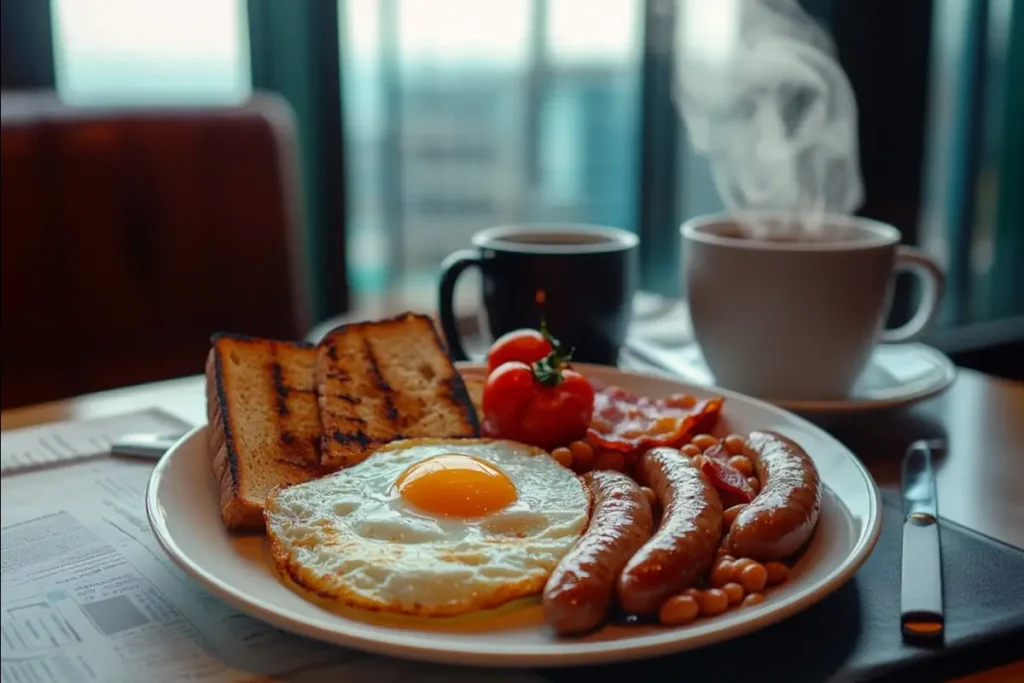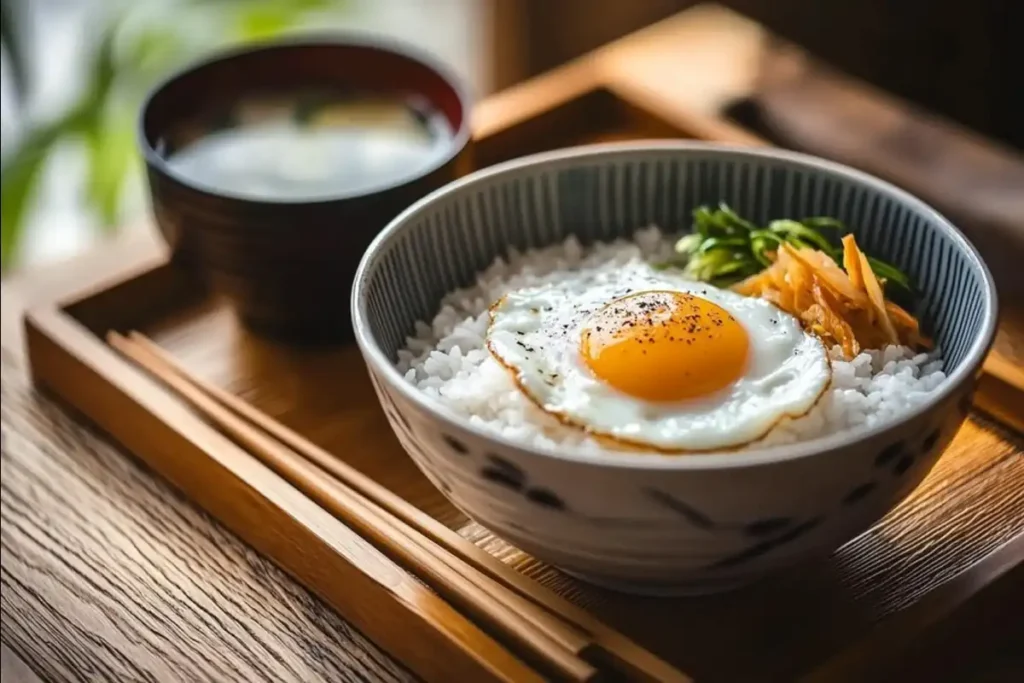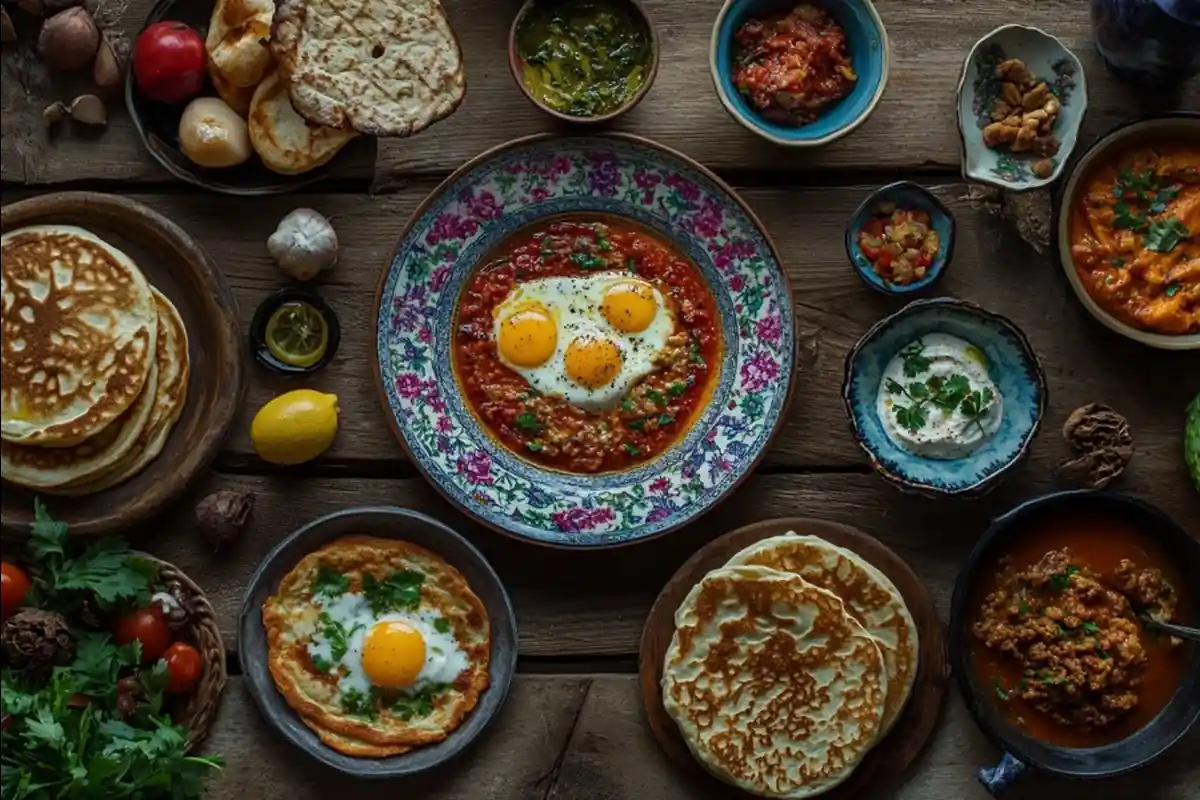Breakfast is often hailed as the most important meal of the day, and for good reason—it sets the tone for our energy levels and mood. Around the world, this meal takes many forms, from hearty plates brimming with meats and eggs to lighter fare like fruits and pastries. In this article, we’ll explore what is a traditional breakfast across cultures, diving into its historical significance, regional variations, and even recipes to bring these flavors into your home. Whether you’re a foodie or just curious about global culinary customs, you’re in for a treat.
1: Defining Traditional Breakfasts
What Does ‘Traditional Breakfast’ Mean?
A traditional breakfast typically refers to the customary morning meal in a particular region, often shaped by cultural habits, climate, and available ingredients. These meals serve more than just sustenance—they reflect the culinary identity of a community. For instance, a classic American breakfast featuring pancakes and bacon is worlds apart from Japan’s Tamago Kake Gohan (rice with raw egg), yet both hold a special place in their respective cultures.
The idea of breakfast has evolved, but its essence remains unchanged. It’s the meal that breaks the overnight fast, fueling us for the day ahead. Whether it’s a hearty English fry-up or a Mediterranean plate of olives and bread, traditional breakfasts provide a snapshot of history and culture.
Cultural Variations in Traditional Breakfasts Around the World
From continent to continent, traditional breakfasts display fascinating diversity. In Asia, rice-based dishes like congee or dosa reign supreme. Meanwhile, in Europe, simplicity often takes the lead with items like croissants or muesli. In Latin America, breakfast is a vibrant affair, with staples like arepas and empanadas filling the table.
Interestingly, many traditional breakfasts are influenced by local resources. In coastal regions, seafood is a breakfast staple, while agrarian communities favor grains and dairy. These regional quirks make exploring breakfast traditions a flavorful adventure.
The Importance of Breakfast in Daily Life
Breakfast isn’t just about food; it’s a ritual. In many cultures, it’s a moment to gather with family or ease into the day. Studies show that eating a nutritious breakfast improves focus, mood, and overall health. Traditional breakfasts often excel here—they’re crafted to sustain energy throughout long working days.
But modern lifestyles have disrupted this. Quick breakfasts or skipping the meal altogether are becoming common, leaving a gap in the rich heritage of traditional morning meals. Rediscovering these traditions can remind us of the joy and nourishment breakfast can bring.
2: Traditional Breakfasts by Region
The American Breakfast: Pancakes, Eggs, and More
The American breakfast is iconic, often celebrated for its hearty and indulgent options. A typical spread includes pancakes or waffles drenched in syrup, crispy bacon, scrambled or fried eggs, and toast. Variations often include hash browns or a side of sausage. This meal emphasizes comfort foods that deliver an energy-packed start to the day.
Interestingly, this breakfast style reflects the agrarian roots of the country, where farmers needed a heavy meal to fuel long workdays. Today, the classic American breakfast remains a staple, found in diners and homes nationwide. For related recipes, you can explore American-style dishes like these on recipe blogs.
The Full English Breakfast: A Quintessential British Experience

Few breakfasts are as renowned as the Full English breakfast, or “fry-up.” This traditional morning meal features fried eggs, bacon, sausages, grilled tomatoes, mushrooms, baked beans, and a slice of black pudding, all served with toast or fried bread. Some versions even include hash browns or kippers.
This breakfast emerged during the Victorian era and became popular as a hearty option for the working class. Despite its calorie count, the Full English breakfast is considered a cultural treasure in the UK. Many regional variations exist, such as the Scottish and Irish breakfasts, which incorporate local ingredients like haggis or soda bread.
European Breakfast Traditions: From Croissants to Cold Cuts
In Europe, breakfast often veers towards simplicity. In France, a traditional breakfast features buttery croissants or baguettes paired with jam and café au lait. Conversely, in Germany and Scandinavia, breakfast includes hearty offerings such as rye bread, cold cuts, cheeses, and boiled eggs.
These breakfasts showcase local ingredients and culinary traditions, with a focus on balanced nutrition. They provide a perfect balance of carbs and proteins to keep energy levels steady throughout the day.
Asian Breakfasts: Rice, Noodles, and Diverse Flavors

Asian breakfasts are incredibly diverse, reflecting the continent’s vast culinary heritage. In Japan, a traditional breakfast might include steamed rice, miso soup, grilled fish, and pickled vegetables, all served with green tea. In China, congee—a rice porridge—is a popular breakfast dish, often topped with savory or sweet accompaniments.
Meanwhile, South Asian breakfasts, like India’s dosa with sambar or paratha with curried vegetables, offer a spicy and flavorful start to the day. These meals emphasize local ingredients and spices, ensuring a robust taste profile.
Asian breakfasts, rich in cultural significance and nutritional balance, often feature rice, noodles, and vibrant flavors. To explore these dishes further, visit this guide on Asian breakfast recipes.
Latin American Breakfast Staples: Arepas, Tamales, and More
Latin American breakfasts are a celebration of bold flavors and textures. In Colombia and Venezuela, arepas (cornmeal cakes) take center stage, often stuffed with cheese, meats, or avocado. Mexico’s breakfasts feature chilaquiles, a dish of fried tortillas simmered in salsa and topped with eggs and cheese.
These breakfasts reflect a deep connection to indigenous traditions and locally sourced ingredients. They’re designed to be both satisfying and flavorful, embodying the region’s vibrant culinary identity.
3: Components of a Traditional Breakfast
Common Ingredients in Traditional Breakfasts Across Cultures
At their core, traditional breakfasts often include staple ingredients like eggs, bread, cereals, and dairy. In tropical regions, fresh fruits such as bananas, papaya, or mango might feature prominently. In colder climates, warm and filling ingredients like oats, meats, and root vegetables dominate.
Eggs are a universal favorite, appearing in countless variations—fried, scrambled, boiled, or even poached. Bread, whether leavened or flat, is another cornerstone of many breakfasts, from bagels in America to chapati in South Asia.
Popular Beverages: Tea, Coffee, and Fresh Juices
No breakfast is complete without a drink. In the West, coffee reigns supreme, while tea is the beverage of choice in many Asian and African cultures. Freshly squeezed juices, such as orange or grapefruit, are popular additions to breakfast tables globally.
Cultural preferences shape these choices. For example, masala chai is a staple in India, while green tea is an essential part of Japanese breakfasts. These drinks not only enhance the meal but also provide hydration and essential nutrients.
Sweet vs. Savory: A Global Comparison
While many Western breakfasts lean towards sweet flavors—think pancakes and cereals—savory breakfasts dominate in other parts of the world. In the Middle East, breakfasts like shakshuka (eggs poached in spiced tomato sauce) are common. Similarly, African breakfasts often include stews, breads, or porridges with savory elements.
This contrast highlights how cultural preferences and dietary habits influence breakfast traditions. Both sweet and savory options offer unique nutritional benefits, catering to diverse palates.
4: Traditional Breakfast Recipes
Recipe for a Classic American Breakfast
For those who want to recreate the experience of an authentic traditional breakfast, a classic American breakfast is a perfect start. Here’s a simple recipe:
Ingredients:
- 2 large eggs
- 2 slices of toast
- 2 slices of crispy bacon
- 1 pancake with syrup
- Butter, salt, and pepper
Instructions:
- Cook the bacon: Heat a skillet over medium heat and cook bacon until crispy. Remove and set aside.
- Make the eggs: In the same pan, fry eggs sunny-side-up or scramble them with a pinch of salt and pepper.
- Prepare the toast: Lightly butter and toast the bread.
- Make the pancake: Follow a simple pancake recipe or use a mix. Serve with butter and syrup.
- Plate and enjoy: Arrange everything neatly on a plate for a classic, Instagram-worthy breakfast!
For more recipes that complement this meal, such as breakfast wraps or chicken-based ideas, check out this delicious chicken pita recipe.
How to Make a Full English Breakfast
A Full English breakfast is a hearty and satisfying dish that’s surprisingly easy to prepare.
Ingredients:
- 2 eggs
- 2 sausages
- 2 slices of bacon
- 1 tomato (halved)
- 1 cup baked beans
- 1 slice of black pudding
- Toast or fried bread
Instructions:
- Cook the sausages and bacon: In a skillet, cook sausages and bacon until golden and crispy. Keep warm.
- Grill the tomatoes and mushrooms: Lightly grill tomatoes and mushrooms in the same pan.
- Heat the baked beans: Warm up the beans in a small saucepan.
- Fry the eggs: Fry eggs sunny-side-up.
- Prepare the toast: Toast or fry slices of bread in butter.
- Assemble and serve: Arrange everything neatly on a large plate, and dig in!
If you enjoy hearty breakfast recipes, explore more in our breakfast section for flavorful ideas.
Step-by-Step Guide to Japanese Tamago Kake Gohan (Egg on Rice)
This Japanese breakfast dish is simple yet incredibly satisfying.
Ingredients:
- 1 cup steamed rice
- 1 fresh egg
- 1 teaspoon soy sauce
- Optional: green onions or nori for garnish
Instructions:
- Prepare the rice: Cook rice and serve hot in a bowl.
- Add the egg: Crack a fresh egg over the rice.
- Season and mix: Drizzle soy sauce on top and mix everything thoroughly until creamy.
- Garnish and serve: Top with chopped green onions or nori for extra flavor.
5: The Evolution of Breakfast Habits
How Modern Lifestyles Are Changing Breakfast Traditions
The question of what is a traditional breakfast often leads to a reflection on how it has evolved. With fast-paced modern lifestyles, many traditional breakfast customs are being replaced by quick, on-the-go options. Instead of hearty, sit-down meals, people now turn to smoothies, protein bars, or instant oatmeal.
This shift is largely due to time constraints and an increased focus on convenience. However, many are rediscovering the joys of slow breakfasts, valuing the cultural and nutritional benefits these meals offer.
Health Trends Influencing Breakfast Choices
As awareness about health and wellness grows, traditional breakfasts are adapting. Many recipes now incorporate whole grains, plant-based proteins, and reduced sugar. For instance, swapping out processed bread for sourdough or using alternative flours for pancakes has become common.
The global rise of plant-based diets has also influenced breakfast habits. Dishes like avocado toast or chia pudding reflect this change, blending health trends with the essence of traditional breakfasts.
For more nutritious breakfast recipes, consider exploring articles like this guide on nutrient-rich breakfast ideas.
6: The Role of Breakfast in Cultural Identity
Why Breakfast Is More Than Just a Meal
Breakfast is often seen as the cornerstone of daily life, but it’s much more than a way to fuel the body. Across cultures, traditional breakfasts carry deep significance, representing community, family, and tradition. They offer a glimpse into regional history and values through the ingredients and preparation methods.
For example, the traditional Full English breakfast reflects the hearty meals needed during the Industrial Revolution, while Japanese breakfasts emphasize simplicity and balance. By asking what is a traditional breakfast, we uncover stories of how food connects people to their heritage.
Preserving Traditions Through Breakfast
As modern lifestyles evolve, preserving traditional breakfasts has become a challenge. Fast-paced routines often favor quick fixes like granola bars or protein shakes. Yet, many are rediscovering the beauty of slow breakfasts, where meals are crafted with care and enjoyed at leisure.
This resurgence not only celebrates culture but also promotes mindful eating. By exploring traditional recipes and incorporating them into our routines, we can keep these culinary traditions alive. Whether it’s enjoying a homemade dosa or savoring pancakes with family, traditional breakfasts remind us of the joy of sharing meals.
7: Celebrating Breakfast Traditions in Modern Times
Rediscovering the Meaning of Breakfast
In today’s fast-moving world, breakfast often takes a backseat. But when we consider what is a traditional breakfast, it becomes clear that this meal is more than just food—it’s a ritual, a celebration of flavors and heritage. Each culture brings its own unique take, turning a simple morning meal into a meaningful experience.
From the warmth of a freshly made arepa to the satisfying crunch of toast paired with a steaming cup of tea, traditional breakfasts invite us to start the day with intention and gratitude. They are a reminder of the beauty of connecting with family, culture, and the past.
Embracing Breakfast Traditions in Modern Life
As we navigate modern challenges, incorporating traditional breakfasts into our lives can be a way to slow down and reconnect. Whether it’s trying a new recipe or simply sitting down for a peaceful meal, these small acts can make a big difference.
So, next time you ponder what is a traditional breakfast, let it inspire you to explore, create, and cherish the flavors that define mornings around the world. After all, breakfast isn’t just the start of the day—it’s a celebration of life itself.
8: FAQs About Traditional Breakfasts
What Are Traditional Breakfast Foods?
Traditional breakfasts vary worldwide, from American pancakes and bacon to England’s hearty fry-ups. In Asia, rice-based dishes like Japan’s Tamago Kake Gohan highlight local ingredients. What is a traditional breakfast? It’s a reflection of culture and nourishment.
What Does a Traditional Breakfast Include?
A traditional breakfast balances carbs, proteins, and fats for energy. European breakfasts pair bread with cheese, while Middle Eastern shakshuka mixes eggs with spiced tomato sauce. Drinks like coffee, tea, or juice add the perfect complement, offering a mix of sweet and savory flavors.
What Is the Traditional American Breakfast?
The traditional American breakfast is hearty and indulgent. It typically features eggs, pancakes or waffles, bacon, and toast. Hash browns or grits may also accompany the meal, making it a filling start to the day.
Interestingly, this breakfast style originated in the 19th century as a way to fuel laborers for long hours. Today, it remains a favorite choice, celebrated in diners and homes nationwide.
What Is a Standard Morning Breakfast?
A standard breakfast typically includes simple, easy-to-prepare foods like cereals, bread, and fruit. While less elaborate than traditional breakfasts, these meals still offer essential nutrients. This shift to lighter options reflects modern convenience-driven lifestyles.
9: Conclusion and Final Thoughts
In conclusion, what is a traditional breakfast? It’s more than just a meal—it’s a cultural symbol, steeped in history and flavor. From the hearty Full English breakfast to the light and refreshing Japanese Tamago Kake Gohan, traditional breakfasts showcase the diversity and richness of global cuisines.
As modern trends influence how we eat, revisiting these traditions offers both a culinary journey and a way to connect with heritage. So, whether you’re flipping pancakes or savoring congee, take a moment to appreciate the tradition behind your morning meal. It’s a delicious reminder of how food brings us together.


3 thoughts on “What Is a Traditional Breakfast?”